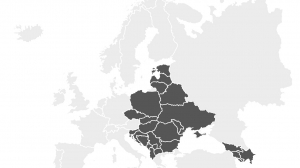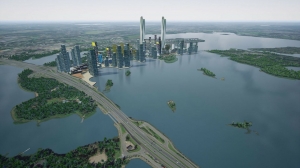Arup Banerji Regional Director, European Union, World Bank
The economic geography of emerging Europe has changed astonishingly fast over the past 30 years. Today, Prague and Bratislava are richer than Île-de-France and Stockholm. Europe’s ‘convergence machine’ has worked. But now it is being challenged by three tectonic shifts.
Technological transformation is redefining European value chains—with cheap skilled labour increasingly irrelevant in choosing locations for production. Ageing and internal migration are destabilising the socio-political and economic balance across generations and geography. And climate change is reshaping opportunities and risks, with agricultural shifts and increased threat of natural disasters.
These global trends are, in turn, causing growing divides among Europe’s people. While richer Europeans thrive, poorer Europeans are left behind by the technological revolution, risks from sudden joblessness, old-age insecurity and natural disasters.
For instance, Romanians in Bucharest enjoy similar living standards as those in Antwerp or Helsinki; but those in North-East Romania are among the poorest in Europe. Just half of the poorest European teens are proficient in mathematics, a foundational skill for technological success.
Ten years from now, the biggest challenge for Europe’s emerging economies will be how to manage these growing divides, so that every European can share in the continent’s prosperity.
—
Johann Strobl CEO, Raiffeisen International
Central and Eastern Europe is our home market. Although the business cycle is past its peak, the overall conditions seem to remain favourable. Thirty years after the fall of the Iron Curtain a lot of progress has been made in CEE, but still there are some challenges ahead.
On the one hand, regulatory barriers have to be examined to create a level playing field for all market participants. We also need a more diverse funding base in CEE. This is not the only reason why further support in the development of local capital markets is important. On the other hand, CEE countries are well equipped for digital development and fintechs have been booming over the past years. We are optimistic that the region will continue to develop favorably.
—
Angelo Lo Vecchio Head of Eastern Europe, Middle East and North Africa, Adecco Group
In a world where talent is fast becoming the key determinant of success, it’s growing to be a scarce resource. Enhancing competitiveness of businesses, institutions and societies has seen a marked transition from an employer-driven environment to an individual-driven one. Complexity growth requires intermingling of multiple skill-sets to create modern leadership that is not border-bound. Without a broader vision of social change, new technologies will only serve to reinforce existing institutional goals and forms of social inequity. Many prior attempts to mobilise technology in the service of educational reform have failed because interventions have focused narrowly on the deployment of particular media or technologies, without considering broader social, political, or economic conditions.
Innovative talent strategies are emerging from all parts of the world, and cities are playing an increasingly significant role in these strategies. Such strategies effect all aspects of talent competitiveness, including education, skilling and re-skilling, attracting external talents and fostering co-creation with local ones, as well as encouraging imported (or returning) talent to stay }and contribute to long-term local objectives.
The emergence of new types of employment in the past few decades, including agency work and job-sharing, has helped to create a more diverse labour market. It’s no longer accurate to describe direct, open-ended, full-time contracts as ‘standard’ and everything else as ‘non-standard’.
—
Sergei Guriev Chief Economist, EBRD
The main challenge for emerging Europe is to switch from investment-based convergence to innovation-led growth. This requires strong economic and political institutions, advanced education and research, and development of deep and resilient financial markets. If this is not achieved, post-communist countries risk becoming a backward periphery of the rich ‘core Europe’ with the latter attracting best human capital from the former; in this scenario, Emerging Europe’s incomes would stagnate resulting in a vicious circle of depopulation, brain drain and slowdown of productivity growth.
Can these risks be avoided? Certainly. Already today, several transition countries are on the right track. The main challenge is to strike the right balance between the state and the market. There should be a strong state to protect property rights and competition, and to invest in infrastructure and human capital. But the state should not be too strong interfering in business decisions. Eventually, innovation should come from the private sector: private entrepreneurs should come up with new ideas and private financiers should select those with best business potential.
—
Mario Holzner Executive Director, Vienna Institute for International Economic Studies (wiiw)
Several long-run challenges are crucial for Central, East and Southeast Europe. Among them are: the transformation of the automotive sector from fossil fuel to electricity based drive technology, the centrifugal forces within the European Union and the massive ageing of societies. If successfully mastered, these challenges can be turned into opportunities for the region over the next decade.
In an optimistic scenario, the Central European automotive cluster reinvents itself, the EU can deepen after Brexit and the positive effects of ageing will prevail. Particularly, wages will start to grow more strongly causing a virtuous circle of economic growth driven by robust household demand and strong investment in labour saving technologies. This will further improve labour productivity and will give an impetus to the region’s convergence process with Western Europe.
—
Luke Dawson Managing Director and Head of Capital Markets CEE, Colliers International
The next decade will be arguably the most pivotal period of development for the countries of emerging Europe. Over the past 30 years we have seen these countries look to define and often redefine their own borders, language, culture, economy and politics. The strides taken and lessons learned have been tremendous but there still remains much work to do.
Over the next 10 years, they will move from adolescences to adulthood. These upcoming “teenage” years will be fraught with the search for identity and recognition, the building and breaking of relationships, changes in direction and the need for independence while still needing parental support in times of crisis. Those countries that focus too much on the past without a strategy to forge their own path and independence, run the risk of falling behind without the historical EU safety net in place from earlier times. It will be the countries that handle this journey with self-awareness, an outward view, and a clear long-term vision that will land in their adulthood with the greatest ease.
As we have seen over the past decade, our countries can succeed on the world stage and use their past as the inspiration for innovation, productivity and change not often seen in their more mature neighbouring countries. Here’s to more of that in the decade to come!
—
Michael Keroulle Chief Commercial Officer, GE Steam Power
What will CEE look like in 10 years, what are the challenges and opportunities?
First, we look at most CEE countries as having significant needs and a huge potential for an upgrade of their infrastructures. This is valid across many sectors and in all the industries where GE is active, especially Energy, where the region needs more efficient and cost effective power generation with lower emissions. This is also valid for healthcare, and to a certain extent for aviation. Second, CEE countries need to improve their ability to attract manufacturing and business with added value. If we look at the World Bank’s Doing Business charts, emerging Europe is lagging behind in terms of ease and speed to establish a business. There is some progress but room for improvement. In 2000, it took 40 days to establish a business, today it is 10 days on average.
However, it takes just one day in the most business friendly places globally. Removing obstacles for investment is fundamental and this is valid for large companies like GE who have size and resources, but more importantly for SMEs, small and medium-sized enterprises, that create some 60 per cent of GDP. Emerging Europe’s countries can breed and become the most favourable place for doing business by eliminating red taping and championing transparent and fair business practices in all sectors.





[…] within Europe’s countries, the story has been one of almost uninterrupted divergence. European regions are pulling away further and further from one another. National growth is being […]